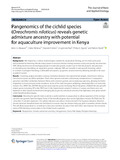Pangenomics of the cichlid species (Oreochromis niloticus) reveals genetic admixture ancestry with potential for aquaculture improvement in Kenya

View/
Date
2023-10-08Author
Mwaura, John G.
Wekesa, Clabe
Kelvin, Kiprotich
Paul, Ang’ienda
Ogutu, Philip A.
Okoth, Patrick
Metadata
Show full item recordAbstract
Background Nile tilapia has a variety of phenotypes suitable for aquaculture farming, yet its entire gene pool with potential for breeding climate ready strains in resource-limited settings remains scanty and poorly documented. SNP calling has become increasingly popular in molecular genetic studies due to their abundance and precision in estimating and identifying an organism’s genetic makeup. SNPs are versatile in trait-specific breeding, which, in contrast to pedigree breeding, is affordable and speeds up genetic advancement by allowing animals to be used as parents sooner. Results Clustering analysis revealed a strong correlation between the experimental sample, Oreochromis niloticus, Oreochromis aureus and Betta splendens. Three other species indicated evolutionary independence. Comparative genomics identified similarities between fishes with common genetic and evolutionary ancestry, allowing for better adaptation to local environmental conditions. Some of the selected genes exhibiting substantial effect on immunity include: Prxs, MMR1 like, ZMYM4-like partial; stress-reactive genes including: PALLD-like gene, LPLBAG6-like and growthrelated genes including: NF1x like, PEDF and CL like. Experimental sample, O. niloticus, O. aureas and Danio rerio, can hybridize in their natural environments bringing about genetic admixture ancestry that hybridizes new genes which confer beneficial phenotypes. Conclusion Breeding for specific traits could be a useful addition to aquaculture to allow expansion of the ecological niche and genetic base for tilapia. Some of the beneficial genes that can be hybridized include Slc25a24 and Slc12member 10, tandem duplicate 1, for salinity tolerance and Abca1, bcl2a and mylk13 for hypoxia tolerance. Breeders should introduce beneficial traits into fish breeds to ensure they are climate ready and able to weather climate shocks. This will allow aquaculture to contribute to food and nutrition security in line with SDG2 and improve the economic status of fish-farming communities in the Global South countries.
URI
https://doi.org/10.1186/s41936-023-00346-6https://basicandappliedzoology.springeropen.com/articles/10.1186/s41936-023-00346-6
http://ir-library.mmust.ac.ke:8080/xmlui/handle/123456789/2353
Collections
- Gold Collection [1026]
